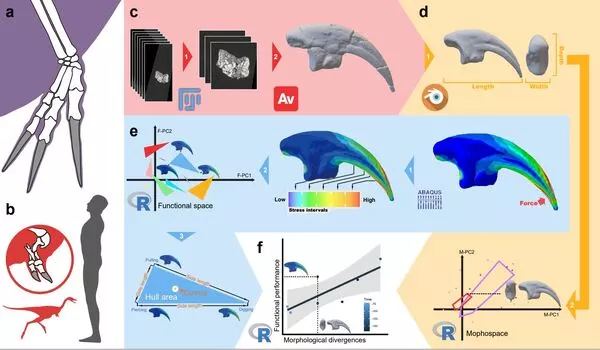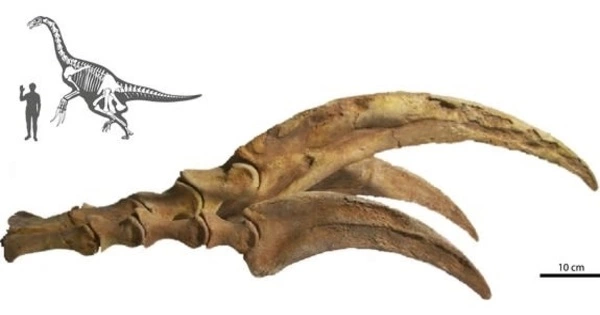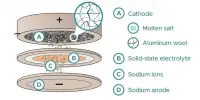Dinosaur claws served a variety of roles, and their functions can be deduced based on their size, shape, and the characteristics of the dinosaur species to which they belonged. Dinosaur claws had numerous purposes, but a team from the University of Bristol and the Institute of Vertebrate Palaeontology and Paleoanthropology (IVPP) in Beijing has discovered that certain predatory dinosaurs utilized their claws for digging or even display.
The study focused on two kinds of theropod dinosaurs, the alvarezsaurs, and therizinosaurs, which featured strange claws whose purpose was unknown until now. The alvarezsaurs utilized their rock-pick-like claws for digging, but their close relatives, the huge therizinosaurs, employed their overdeveloped, meter-long, sickle-like claws for display.
Zichuan Qin, a Ph.D. student at the University of Bristol and the IVPP, is leading the new research. He created a new computational approach in biomechanics to find functions by comparing them to living animals. The claws were first modeled in three dimensions using CT scans, then for stress and strain using engineering methods, and lastly matched to functions of pulling, piercing, and digging by comparison with modern species with recognized claw functions.
Our study shows that the early alvarezsaurs, like Haplocheirus from the Jurassic, had multifunctional hands, but they were not good at digging. Their much smaller descendants had the efficient digging hands so they could feast on the Late Cretaceous termites.
Zichuan Qin
“Alvarezsaurs and therizinosaurs are definitely the strangest cousins among dinosaurs,” said Professor Michael Benton, one of Zichuan’s supervisors. “Alvarezsaurs were the tiniest dinosaurs ever, the size of chickens, with stubby forelimbs and robust single claws, but their closest relative, the therizinosaurs, evolved in the exact opposite path.”
“Therizinosaurus is well-known for its sickle-like claws, each as long as a samurai sword: Edward Scissor-hands on steroids.” In ‘Jurassic World,’ we all saw Therizinosaurus attack deer and slay the gigantic predator Giganotosaurus. This, though, is unlikely. These lengthy, narrow claws were too feeble to fight with.” Dr. Chun-Chi Liao, an IVPP therizinosaur expert who co-authored this paper, agreed. “Our engineering simulation shows that these claws could not withstand much stress.”
Some dinosaurs had digging claws that allowed them to excavate burrows, hunt for food, and build nests. The dinosaur’s claws were typically strong, curved, and pointed, allowing it to apply force and break through the ground. Theropods with digging claws, such as Oviraptor, most likely used their claws to excavate and manipulate materials when building nests.

“While not all therizinosaur hand claws were useless in combat, most other related species could use their claws as powerful hooking tools when feeding on tree leaves. So, we conclude that the largest claws of any animal ever were actually useless in mechanical function, and thus must have evolved under sexual selection to be used in display,” Dr Chun-Chi Liao added. “I suppose an adult Therizinosaurus could wave its claws at a competitor and effectively say, ‘look at me, back off,’ or wave them around in some way similar to how a peacock can use its tail in display to attract females for mating.”
“Our previous work has shown that alvarezsaurs evolved to become the tiniest dinosaurs by the end of the Cretaceous, and these [dinosaurs] were using their punchy little claws for digging into ant hills and termite mounds. They were ant-eaters,” said Zichuan Qin.
“Our study shows that the early alvarezsaurs, like Haplocheirus from the Jurassic, had multifunctional hands, but they were not good at digging. Their much smaller descendants had the efficient digging hands so they could feast on the Late Cretaceous termites.” added Zichuan Qin.
“Science and technology cannot bring dinosaurs back to life, but advanced computing and engineering techniques can show us how extinct animals lived,” said Professor Emily Rayfield, one of Zichuan’s supervisors and an expert in dinosaur biomechanics.
“Especially for extinct animals like alvarezsaurs and therizinosaurs, they are so bizarre that no living animals resemble them.” Fortunately, technological technology allows us to recreate the functioning of extinct animals on a computer utilising fundamental engineering and biomechanical concepts. This study demonstrates very well how selection for function can result in the formation of certain, often strange, shapes.”
















